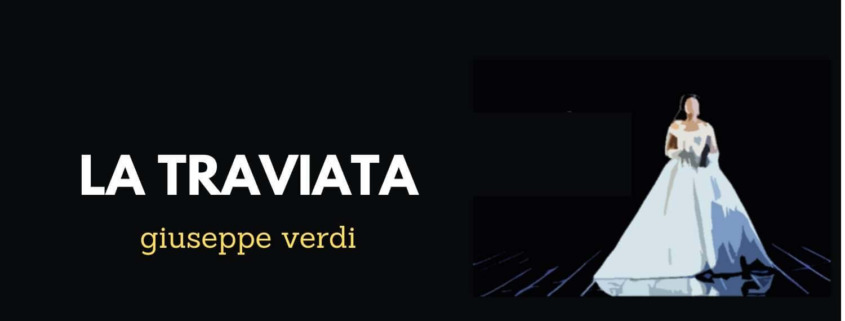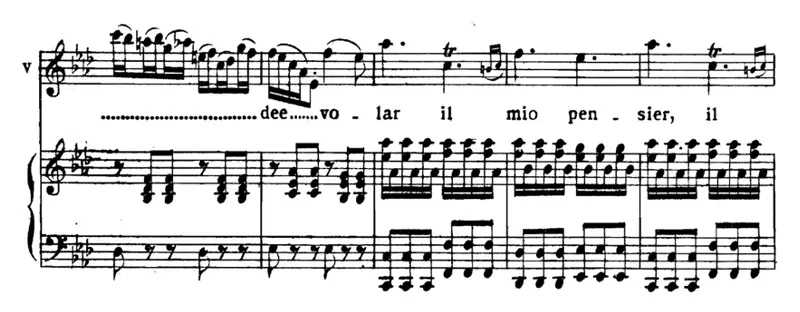AH FORS’È LUI … SEMPRE LIBERA – an aria from the opera La Traviata
The online opera guide of Verdi’s Aria SEMPRE LIBERA
Read Interesting facts and hear great YouTube Videos about the famous Aria “SEMPRE LIBERA” and “AH FORS È LUI”.
If you want to hear more about the opera La Traviata, click on the link to the opera portrait
The aria – synopsis and background
Synopsis: Alfredo is in Violetta’s salon. He confesses to her that he has loved her secretly for some time. Violetta, the Parisian courtesan and lady of society, feels attracted to Alfredo and for the first time in her life feels a need for love, but also knows about her serious illness. In this passage she is torn between a budding love (ah fors è lui) and an unbound life (sempre libera).
This aria is the longest of its kind written by Verdi. It lasts over 10 minutes (including recitatives), and requires the singer to have the highest vocal abilities as well as great stamina.
This scene of Violetta consists of two parts: it begins with a thoughtful “ah fors è lui”, a lyrical piece which has to be sung with beautiful sound quality and colours.
It is followed by “Sempre libera”, which requires the abilities of a coloratura soprano with many virtuoso runs and high notes. In addition to these vocal abilities, the singer must give the role a tremendous dramatic impetus, which must convey to the listener Violetta’s emotional state of emergency, who is torn between love, tragedy (illness) and joie de vivre, that leads to an ecstatic stretta which concludes this fantastic piece.
Ah fors è lui
The aria begins with a questioning motif in the horns. The “A fors è lui” is written in minor which reflects the desperate hope of Violetta. It begins in p and dolcissimo:
For Violetta, it is a delicate dream she must sing about so tenderly that it does not burst. With the mention of Alfredo (lui, che modesto) the voice becomes firmer and goes over into the emotional cantilena “ah quel amor”, which is woven into a tender dotted melody of the flute. After a repetition Violetta ends this first part with a short cadenza.
Sempre libera
Abruptely Verdi tears Violetta out of her dream and she cries “Follie”. Bitterness is in her voice. The coloraturas on “Vortici” and “Perir” express the pain she feels. The following coloratura chain on “Gioir” swings up to the high D flat and then leads into the allegro brillante of the aria “Sempre libera”. The music changes into the salon atmosphere with the orchestra’s intoxicating waltz rhythm. The many coloraturas are difficult and must be sung elegantly and easily. A virtuoso cadenza leads to the recapitulation of the “sempre libera”. Cascades of high notes with many C and D follow and lead into an extatic stretta (il mio pensier) that consists of fast runs with virtuoso ornaments like grace notes and trills:
The Aria – the text of SEMPRE LIBERA
È strano! è strano! in core
Scolpiti ho quegli accenti!
Sarìa per me sventura un serio amore?
Che risolvi, o turbata anima mia?
Null’uomo ancora t’accendeva O gioia
Ch’io non conobbi, essere amata amando!
E sdegnarla poss’io
Per l’aride follie del viver mio?Ah, fors’è lui che l’anima
Solinga ne’ tumulti
Godea sovente pingere
De’ suoi colori occulti!
Lui che modesto e vigile
All’egre soglie ascese,
E nuova febbre accese,
Destandomi all’amor.
A quell’amor ch’è palpito
Dell’universo intero,
Misterioso, altero,
Croce e delizia al cor.
A me fanciulla, un candido
E trepido desire
Questi effigiò dolcissimo
Signor dell’avvenire,
Quando ne’ cieli il raggio
Di sua beltà vedea,
E tutta me pascea
Di quel divino error.
Sentìa che amore è palpito
Dell’universo intero,
Misterioso, altero,
Croce e delizia al cor!Follie! follie delirio vano è questo!
Povera donna, sola
Abbandonata in questo
Popoloso deserto
Che appellano Parigi,
Che spero or più?
Che far degg’io!
Gioire,
Di voluttà nei vortici perire.
Sempre libera degg’io
Folleggiar di gioia in gioia,
Vo’ che scorra il viver mio
Pei sentieri del piacer,
Nasca il giorno, o il giorno muoia,
Sempre lieta ne’ ritrovi
A diletti sempre nuovi
Dee volare il mio pensier.
How strange it is … how strange!
Those words are carved upon my heart!
Would a true love bring me misfortune?
What do you think, o my troubled spirit?
No man before kindled a flame like this.
Oh, joy …
I never knew …
To love and to be loved!
Can I disdain this
For a life of sterile pleasure?Was this the man my heart,
Alone in the crowd,
Delighted many times to paint
In vague, mysterious colours?
This man, so watchful yet retiring,
Who haunted my sick?bed
And turned my fever
Into the burning flame of love!
That love,
The pulse of the whole world,
Mysterious, unattainable,
The torment and delight of my heart.It’s madness! It’s empty delirium!
A poor, lonely woman
Abandoned in this teeming desert
They call Paris!
What can I hope? What should I do?
Enjoy myself! Plurge into the vortex
Of pleasure and drown there!
Enjoy myself!Free and aimless I must flutter
From pleasure to pleasure,
Skimming the surface
Of life’s primrose path.
As each day dawns,
As each day dies,
Gaily I turn to the new delights
That make my spirit soar.
Written for a “dramatic coloratura soprano”
The role of Violetta is written for a dramatic coloratura soprano. The dramatic coloratura soprano must have both coloratura ability and the ability to master dramatic expression with a larger vocal volume. If this voice can also sing lyrical parts, so it can happen that the “dramatic coloratura soprano” can sing a wide repertoire.
Famous interpretations of SEMPRE LIBERA
You will hear the first version from Maria Callas. She was one of the greatest interpreters of the Violetta. With her tremendous vocal abilities she was able to captivate both in the coloratura part and in the dramatic area. Especially her Lisbon Traviata became a legend. Read more about it in the guide of this opera.
Sempre libera (1) – Callas
The next recording is by Magda Olivero (1910-2014). She had an ardent following that adored her. Her career lasted a long time, for example she sang her debut at the Met Opera with 65 (!) years in the role of Tosca. Listen to the gripping role portrait and her virtuoso interpretation.
Sempre libera (2) – Olivero
Next is a wonderful «Sempre libera» of Angela Gheorghiu in a 1995 recording. The birth of the total recording of the Traviata has something magical about it. The key event was her encounter with Georg Solti. Solti wanted to produce his first Traviata at the age of 84 with fresh artists and met Angela Gheorghiu. At a hearing she convinced him immediately, he was thrilled. The opening night was a triumph and the rest is legend:
Sempre libera (3) – Gheorghiu / Solti
Next you hear Diana Damrau. For a long time, the German was associated with the role of Queen of the night. Her great coloratura abilities and the effortless mastery of high notes enabled her to sing this extremely difficult Mozart aria brilliantly. Listen to her in Sempre libera.
Sempre libera (4) – Damrau
In the excerpts to «Sempre libera» you will find now four historical audio documents, each with «Assolutas». One with the famous Nellie Melba, one of the greates soprano voices ever recorded. Listen to the 1906 recording of «Ah, forse lui…sempre libera». Kesting: «The declamatory pathos of the beginning could hardly have been expressed more urgently with purely vocal means.»
Ah, fors’è lui…sempre libera (5) – Melba
A second one with Rosa Ponselle, who is together with Nellie Melba perhaps the greatest of the Italian discipline in the «golden era». Still today the sopranos sing Melba’s cadenza of Lucia’s madness aria (listen to my blog about Lucia di Lammermoor, second part). But let’s come to the Traviata with the words of Kesting: «… and yet it is the most exciting Violetta of all the complete recordings (only when I hear Callas do I want to forget that). The incredulous-questioning tone of «è strano» is produced solely by the iridescent sound. The expressive accentuation of «Ah, fors’ è lui» is unforgettable. Which bows and which sound development with «ah! Quell’amore»! What cheering love madness in the «follie» shouts.» Hear Rosa Ponselle.
Ah, fors’è lui…sempre libera (6) – Ponselle
In number three you hear Lilli Lehman. She was born in 1848, her art is deeply rooted in the 19th century, for example she sang at the premiere of the Bayreuth Festival, directed personally by Richard Wagner. She is the only singer of the first Wagner generation from who exist recordings, she thus became «stylistically influential for a generation» (Fischer). Lili Lehmann’s repertoire was very large. «There are two recording series of her from the years 1905 and 1906 when she was already approaching her 60th birthday which can give an impression of this great singer personality. (Fischer, grosse Stimmen), of which «the piano accompanied recording of «Fors è lui» belongs to the great Lehmann records» (Kesting).
Ah, fors’è lui…sempre libera (7) – Lehmann (Lili)
Licia Albanese sings the sempre libera with fast tempo and a lot of fire. The aria is played under the direction of Toscanini. Toscanini (1867-1957) knew Verdi personally. “When Toscanini was already a respected kapellmeister at a young age, Toscanini returned temporarily to his chair in the cello section of the Scala and took part as a cellist in the premiere of Verdi’s Otello (La Scala, Milan, 1887) under the direction of the composer. Verdi, who usually complained that conductors never seemed interested in conducting his scores the way he had written them, was impressed by reports by Arrigo Boito of “Toscanini’s ability to interpret his scores” (source: Wikipedia).Toscanini was famous for the fidelity to the works that he applied to them.
Sempre libera (8) – Albanese
Peter Lutz, opera-inside, the online opera guide to the Aria “SEMPRE LIBERA” from the opera La Traviata.






Leave a Reply
Want to join the discussion?Feel free to contribute!